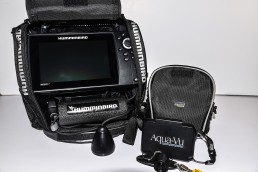Ice Electronics, Then and Now
SHARE THIS POST
Scott Petersen has found that ice electronics can play a big part in your ice fishing success, day-in and day-out.
The biggest change on the ice scene in the last 20 years has been in the ice electronics category. What was just starting to take the ice world by storm back then was the introduction of the Vexilar FL-8 flasher. It was a single-color flasher (red) that allowed you to track your bait falling through the water to fish waiting below. You could say that was maybe the first shot across the bow by developments that put today’s ice fishing on its current path.
Let’s take a closer look at just how much ice electronics have changed in the past 20 years.
Flashers
When the FL-8 was introduced to the ice market, it was the early leader; in fact, you could say it was almost in a market by itself. The next step also came from Vexilar, as it introduced the first three-color flasher. This has long been the leading flasher unit on the ice market, and is still the one of the most-sought-after ice units today. Through the years, a few more companies have entered into competition with Vexilar, although they still dominate the market.
At this point, you could say that there are two camps of thought when it comes to ice electronics: You have diehard flasher ice fishermen, and then you have a new, emerging group of ice fishermen now leaning towards using LCD units for their ice fishing.
Today’s LCD units
To combat flasher domination in the ice market in the early years, there was the thought that an LCR (liquid crystal recorder, now commonly referred to as LCD or Liquid Crystal Display) could do what a flasher could—and more. They were making very good headway in the open-water market, but were struggling to gain any traction in the ice market. The biggest drawback in the early years was screen speed. They were too slow to keep up with a flasher at that time, and had performance issues in extremely cold temperatures.
Fast forward and you’ll find today’s LCDs can read just as fast as today’s ice flashers, leaving a true choice for ice fisherman as to their preference.
Today’s LCD units offer ice fishermen one thing that flashers cannot: the power of GPS mapping. With a unit like Humminbird’s Helix 7, you get a combination of different screen choices and looks, along with the power of GPS and mapping. This is what truly sets this unit apart from the flasher option in the ice electronics market.
Are you enjoying this post?
You can be among the first to get the latest info on where to go, what to use and how to use it!
The built-in GPS option is what is leading more ice fishermen towards using an LCD unit on the ice. With the GPS and map chip combination, you can be fishing in one area, and look for these same features elsewhere on the lake map, and then go there while following your trail on the map.
Another feature of the GPS is that it is a lot easier to lay out areas with the mapping power in your hands. I use my Helix 7 unit to trace the depth contour outline that I want to fish, doing so while on my 4-wheeler as I run. I can then go back and see how it lays out, and drill holes along the depth contour that I want to target.
It even makes ice shelter placement more accurate. This no different than how you use your boat and electronics during the summer months; you can do the same when ice fishing now.
Underwater cameras
If you want a shortcut to finding fish beneath the ice, and a look at how things lay out below, then an underwater camera is your pick. By dropping a camera down, you can look for fish presence, the size of the fish, and overall, how the cover and the area looks.
I’ll say this for the power of the underwater camera: There are ice fishermen that are not even using anything but a camera today to scout holes, looking for fish, looking at cover and to detect bites.
Research your options, and see what units fit into your budget. No matter where you jump in, you are putting more odds in your favor with ice electronics than without.
Gain more knowledge from the pros who know! Read the December issue of MidWest Outdoors, available the first full week of December at the newsstand or by subscribing on our website.
MWO
SHARE THIS POST
You may also like...
Nothing found.
Did you enjoy this post?
You can be among the first to get the latest info on where to go, what to use and how to use it!
Scott Petersen
Scott Petersen has been writing for the past 30 years. A Minnesota native, he has a passion to fish all seasons on ice and open water. “One of my main goals is to teach people how to fish through my articles and sport-show seminars.”
